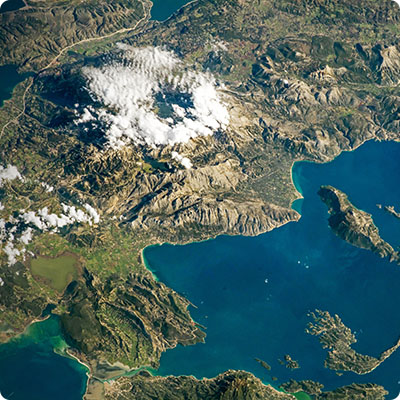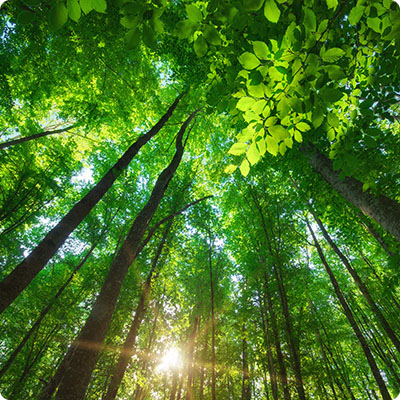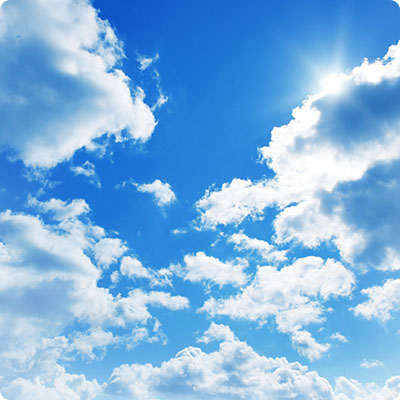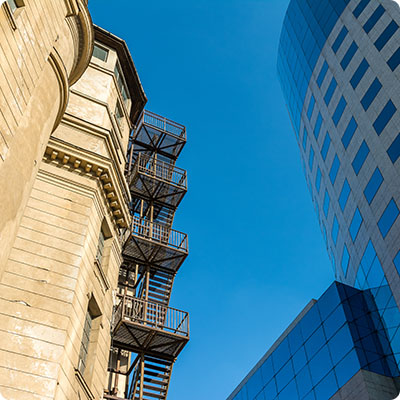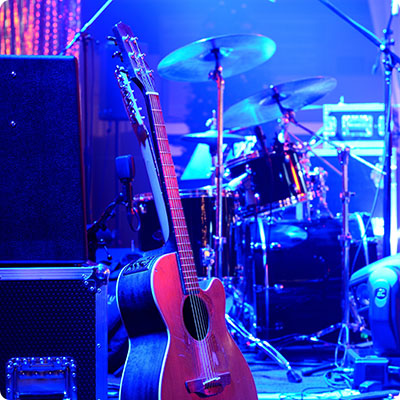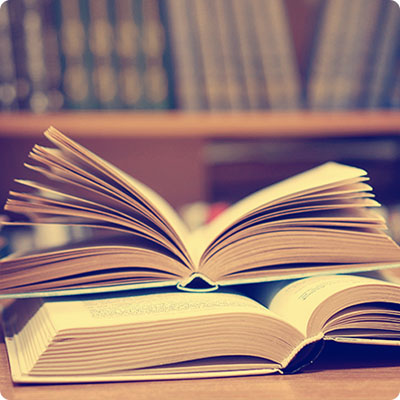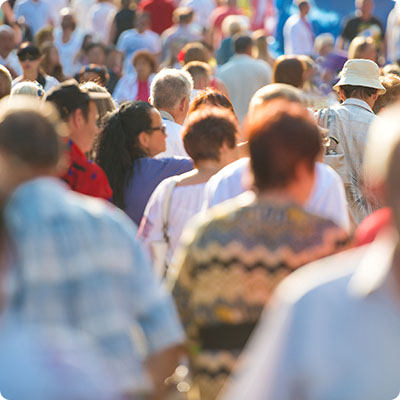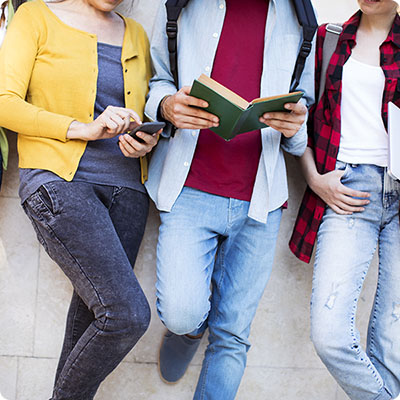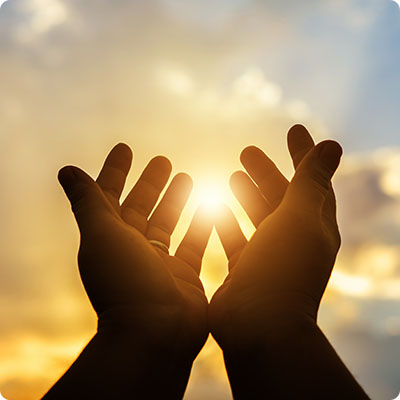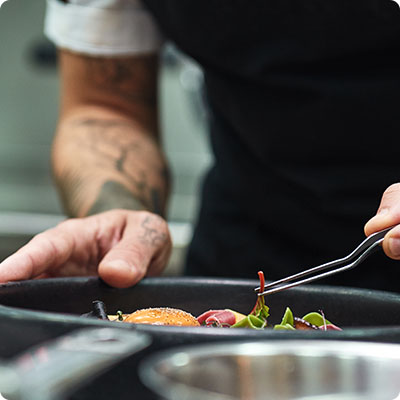Peninsular and East Malaysia
The country's name derives from the name of the majority ethnic group, the Malays, although its citizens are referred to as Malaysians. According to the latest figures from the Malaysian Department of Statistics, the country will have a population of almost 32.5 million in 2020. The population has more than tripled since 1970. Population growth is strongly encouraged by the government, as the country is much less densely populated than its Thai and Indonesian neighbors. The population, which is growing at around 1.5% a year, is young: 44% are under 20, and only 6% are over 60. The country has one of the highest literacy rates in Asia: 93% of the population can read and write. Over 70% live in urban areas on the peninsula, but only just over 55% in East Malaysia. There are 22.5 million Malaysian citizens on the peninsula, and 5.7 million in East Malaysia (Sarawak and Sabah). The remainder are non-citizens. In addition, Malaysian citizenship in the states of Sarawak and Sabah is distinct from that of Peninsular Malaysia, in order to better control migratory flows. With the growth of labor-intensive industries, the country is home to an estimated 3 million migrant workers. NGOs estimate that 2 million of Sabah's 3.75 million inhabitants are illegal immigrants, mainly from the Philippines and Indonesia.
Ethnic groups. The population is made up of three main groups. The Bumiputeras, "sons of the soil" in Malay, make up 69.7% of the population. These are mainly ethnic Malays (62%) and indigenous ethnic groups (mainly Orang Asli in the peninsula, Dayak in East Malaysia), who account for 7.7% of the population. Chinese (or Sino-Malaysians) account for 22.8% of the population, while Indians (or Indo-Malaysians), whose ancestors came mainly from South India, make up 6.8%. While all these ethnic groups seem to live in harmony, political and religious tensions occasionally arise. The notion of a Malaysian national identity is gaining ground, but each community wishes to preserve its own culture and traditions. Generally speaking, Malaysians have a well-developed sense of hospitality that delights travelers.
The Malays (Orang Melayu). This is an Austronesian ethno-religious group originating from what are now the Malay Peninsula, coastal Borneo, Kalimantan Barat and eastern Sumatra (Indonesia), parts of southern Thailand (Pattani, Satun, Songkhla, Yala and Narathiwat), Singapore and Brunei. There are many sub-groups with great linguistic, cultural and social diversity, mainly due to hundreds of years of immigration and assimilation of various ethnic groups and indigenous tribes. According to the Malaysian constitution, a Malay is defined as an individual of Muslim faith who speaks Malay, conforms to Malay customs, and is the child of at least one parent born within the Federation of Malaya prior to independence on August 31, 1957. The Malays play a leading role in the country's politics. In East Malaysia, they make up just under 25% of the total population of Sarawak, and only 7% of that of the state of Sabah. Muslims, the Malays consume no pork, eat halal food, observe daily prayers (especially Friday prayers - most businesses close on this occasion), and observe Ramadan. Favored by the national economic policy introduced by the government in the 1970s, many Malays now belong to the middle class. Educated Malays living in urban areas are still strongly imbued with their traditions, and frequently return to their villages(kampungs) to celebrate religious festivals with their families. Men mainly wear Western clothes and a small skullcap (songkok) during prayers. Malay women wear a scarf(tudong) covering their hair, but not their face. Traditional clothing is worn more in rural areas and on official and religious holidays. The Malays speak good English and are very welcoming, making it easy to talk to them during your trip. The women also enjoy chatting with Western tourists, and ask many questions about their way of life.
Sino-Malaysians (Orang Cina). The Chinese of Malaysia, who belong to the Han ethnic group, originally come from southern China. In Malaysia as a whole, they make up 22.8% of the population, 23.3% of Sarawak and 7.8% of Sabah. The first record of their arrival in Malaysia dates back to 1292, when the Mongol expedition led by Kubilai Khan (the grandson of Genghis Khan) landed in Borneo in preparation for the invasion of Java the following year. Following this campaign, a number of Chinese merchants and Khan's followers established a small enclave along the Kinabatagan River (now in the state of Sabah). They were well received by the indigenous communities, who benefited in particular from goods brought by the Chinese, such as pottery, jars and silk. The maritime explorer Zheng He then led several expeditions to Southeast Asia in the early 15th century, enabling him to establish lasting trade links during the rise of Malacca, a city on the Malaysian coast. These ties continued when the kingdoms of Malacca and Brunei were Islamized. Muslim sultans and Chinese dynasties joined forces to counter the invasions of their powerful neighbors, the Siamese kingdom of Ayutthaya and the Javanese Majahapit. At the end of the 14th century, the princess Hang Li-Po was sent to Malacca to marry the sultan and establish a lasting alliance between Malacca and China. This was to be the origin of the Nyonya culture, still present today in Malacca, Penang, Kuching and even Phuket in Thailand. In addition to the enclaves of Kinabatangan and Malacca, two other Chinese trading posts were established in Terrenganu and on the island of Penang to consolidate maritime trade routes in these regions. When the Portuguese seized Malacca in 1511, most Chinese traders avoided the area, although this did not weaken the important Chinese migratory flow. In 1641, following the Dutch conquest of Malacca, Malacca's Chinese were enlisted to build Dutch edifices. At the beginning of the 19th century, the British colonized various states on the Malay Peninsula and Singapore, as well as northern Borneo, then comprising the present-day territories of Sarawak, Sabah, Brunei and the territory of Labuan, for what was commonly known as British Malaya. British colonization brought with it the largest wave of migration from China, in particular as laborers in mining, construction and transport. The Chinese established themselves over the long term, adapting to the Malay way of life while retaining their own culture. Today, Sino-Malaysians play a major role in Malaysia's economy, controlling much of the country's trade and industry. They are mainly settled in large urban areas such as Kuala Lumpur and the state of Penang, but also in Kuching and Kota Kinabalu, the two state capitals of East Malaysia in Borneo.
Indo-Malaysians (Orang India Malaysia). The majority of Indians are descendants of the Indians who immigrated to British Malaysia from the mid-19th century onwards. 80% are Tamils whose ancestors came from Tamil Nadu, while the remainder are descendants of Malayalis from Kerala, Telugus from what are now Andhra Pradesh and Telangana, and a few Punjabis. Today, Indians make up 6.8% of Malaysia's total population. Ancient India has long had a strong influence in Southeast Asia. Pre-colonial Malaysia was already part of the Indianized kingdoms of Srivijaya and Majapahit from the 7th century onwards. After the Portuguese conquered Malacca in 1511, the Portuguese government encouraged explorers to bring their Indian Catholic wives, mainly from Goa and Bombay. Especially when the British acquired Malacca, Penang and Singapore, a large workforce was imported from India: traders, workers on tea and rubber plantations, policemen, soldiers (cipayes)... Today, the Indian community is present in urban areas and around oil palm plantations. Often scorned by other ethnic communities, Indians are nonetheless an important part of Malaysian society. Although they are very open to other cultures, they retain their traditions and beliefs, whether Hindu, Buddhist, Sikh, Muslim or Christian, and forge deep bonds within their communities. They generally run small businesses or work on oil palm plantations, but others from the upper classes also play an important economic role in the business world. Their better command of the English language is an asset. Indians are more numerous in Peninsular Malaysia than in Borneo.
The indigenous people of East Malaysia. Indigenous tribes are in the majority in the states of Sarawak and Sabah. The natives of the island of Borneo are commonly referred to as Dayak, a name used by the British and later the Dutch to designate indigenous peoples. However, for the inhabitants of East Malaysia, the term Dayak refers more specifically to the indigenous Iban and Bidayuh ethnic groups.
In Sarawak, indigenous ethnic groups make up around 48% of the state's population. The main ethnic groups are the Iban (28.8% of Sarawak's population), Bidayuh (8%), Melanau (4.9%) and other Bumiputeras (6.3%, mainly Orang Ulu). According to their legends, the Iban people originated on the banks of the Kapuas River, and moved to what is now Sarawak in the 1750s. Called "Sea Dayaks" by the British, they are the state's largest tribe. The Iban, whose bodies bear the tattoos of their lives and exploits, are the legendary and fearsome head-choppers of the Borneo jungle. This practice has gradually disappeared since the arrival of the British, and the Iban have converted to Christianity. However, they retain their animist customs, traditions and language. The tattoos they wear today have more of a symbolic and cultural significance. They live inland, mostly along the Ai, Rajang and Lupar rivers and their tributaries, in traditional collective houses known as longhouses. Previously built on stilts using local materials, these dwellings are unique in that they house all the members of a village, with a lengthy structure. Today, most longhouses have been modernized for comfort and safety, and are built with resistant materials. The Bidayuh population is concentrated in the west of the island, mainly around Kuching. Like the Iban, they have converted to Christianity but still retain animist practices. They are renowned for their hospitality and for their tuak, the local rice alcohol. The Melanau are mainly fishermen, living in large wooden houses on stilts. Converted to Islam, their way of life is now similar to that of the Malays. Another important ethnic group in Sarawak is the Orang Ulu community, "the people up the river". They are renowned for their artistic talents: finely carved wooden longhouses with rich wall decorations, and intricately patterned tattoos. Other ethnic groups are also present in Sarawak: the Kayan, Bisaya, Lun Bawang, Kelabit, Kenyah, Penan, Punun Bah..
In the state of Sabah, indigenous tribes account for over 50% of the population. There are 33 different indigenous ethnic groups. More than 30% of the state's total population is made up of the Kadazan-Dusun ethnic group, a term referring to the unification of two indigenous tribes, the Kadazan and the Dusun. Christian, they are traditionally rice-growing farmers. They are distinguished by their Bohohizan, female priests who preside over their religious rites. They are also famous for their traditional ancestral dance: the Sumazau dance. The Bajau people live mainly on the coast. Known as the "cowboys of the east" inland for their equestrian skills, or the "sea gypsies" along the coast for their diving abilities, they are essentially fishermen. The Muruts, "people of the hills", form a community comprising some thirty ethnic sub-groups living in the northern interior of the island. They are the last ethnic group to renounce the practice of cutting off the heads of enemies, an essential part of their spiritual beliefs. Other indigenous peoples of the state include the Rungus, Iranun, Bisaya, Tatana, Lun Dayeh, Suluk, Sino, Ida'an, Bugis, Kagayan, Tindal, Tobilungm Lobu..
Brunei Darussalam
The population of the small sultanate was estimated at 450,500 in 2023, and is growing steadily (around 0.85% per year). The population is predominantly Malay (65.8%), with significant Chinese (10.2%), Indian and indigenous (23.9%) populations. Malays belong to one of seven ethnic groups: Melayu Brunei, Kedayan, Dusun, Tutong, Belait, Murut or Bisaya. Each of these seven ethnic groups is characterized by distinct aspects of its own culture, lifestyle, mother tongue, customs and traditions. Women make up 47.2% of the population, or around 212,800 individuals. The societal structure is largely characterized by an extended family system, with an average of 6 people per household. The Sultanate's citizens are predominantly Muslim (78.8% of the population), with the remainder being Christian (8.7%), Buddhist (7.8%), and the rest (4.7%) of various denominations, including animists. Culture and laws are strongly influenced by a very conservative Islam (Sharia, Islamic law, was introduced in 2014). All Muslims are obliged to attend the collective Friday prayer.
Kalimantan
In 2023, the population of Kalimantan, the Indonesian part of the island, will number around 17.26 million, according to Statistics Indonesia, an Indonesian government institute. This population is distributed across the state's five provinces as follows: 5.96 million in West Kalimantan, 4.22 million in South Kalimantan, 4.03 million in East Kalimantan, 2.81 million in Central Kalimantan and just 746,000 in North Kalimantan. Like East Malaysia, Kalimantan has undergone a significant ethnic intermingling, which is perfectly illustrated by the Indonesian national motto, "Unity in Diversity" (" Bhinneka Tunggal Ika "). The largest ethnic group is the Banjar (26% of the total population), followed by the Dayak tribes (22%), the Javanese (18.2%), the Malays (11.5%), the Bugis from the Celebes Islands (7.2%), followed by the Madurese, Chinese, Kutais and Sudanese. The Banjar people are an Austronesian ethnic group native to southeast Kalimantan. 99.5% of Banjars are Muslims, and over the centuries they have assimilated with Malays, Javanese and Dayaks. In Kalimantan, the term Dayak is applied to all the non-Muslim indigenous peoples of the island's interior, as opposed to the predominantly Malay population of the coastal areas. Although it is sometimes difficult to establish precise demarcation lines, the most important of the many Dayak sub-groups are the Kayan (generally called Bahau in Kalimantan) and Kenyah in eastern and central Kalimantan, the Ngaju in central and southern Kalimantan and the Bidayuh in the west.
